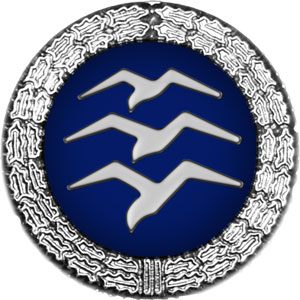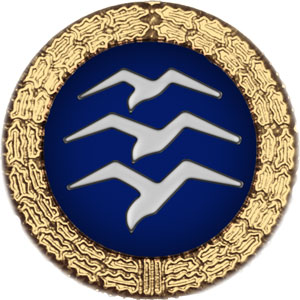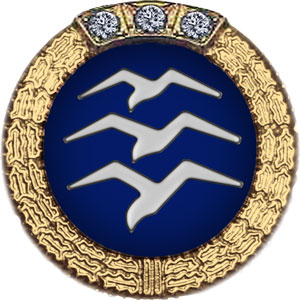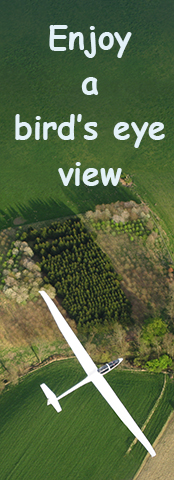The Gliding Cerificate and Badges
Gliding skill levels are recognised by a Gliding Certificate and Endorsements and by FAI Badges.
The Gliding Certificate
In the UK, the Gliding Certificate is issued at the same time as the Solo endorsement.
The Solo Endorsement
The Bronze Endorsement
To qualify for the Bronze Endorsement, you need to have completed 50 solo flights, at least 3 check flights with an instructor who will exercise your flying skills fully. A good theoretical knowledge is also required as you also need to pass a written multiple-choice examination with 10 papers. Air Law and Air Traffic, Human performance, Meteorology, Communications, Principles of flight, Operational Procedures, Flight Performance and Planning, Airmanship, Aircraft General Knowledge, and Navigation.
Cross-country Endorsement
Up to now you will have been required to stay within gliding range of your airfield. Of course this can be quite a long way depending on what height you've been able to achieve but nevertheless you will not have been allowed to set off into the blue yonder. To do that you need to get your Cross-country Endorsement. This is intended to demonstrate that you have acquired the skills needed to navigate across country, obeying the rules of the air, making use of whatever lift you can find along the way, be able to pick a safe landing area and land safely in it.
For this Endorsement, you need to have flown at least 1 soaring flights of at least 1 hour. You then need to plan and execute landings into off-site areas such as grass fields, and plan and execute a triangular flight of at least 100 kilometres. If one is available you can use a motorglider for the last 2 tests and even a light aircraft for the navigation test since it is not your actual glider control skills which are being tested. When you have passed this Endorsement you will be allowed to fly away from your own airfield under the scrutiny of the Duty Instructor. The minimum age for Cross-country Endorsement is 16years.
At this point you can if you wish start to tackle the FAI badges which are set and recognised internationally by gliding's international supervisory body, the Fédération Aéronautique Internationale (FAI). From this point on all of your badge claims will be based on solo flying, it is entirely up to you(under supervision) to plan and execute the necessary tasks for each badge step. To prove that you have achieved your claim, you need to carry a logger which records your height and gps position.
The Silver Badge
 You need to make at least 1 flight of 5 hours duration. You need to achieve a gain in height of 1000 metres from the lowest point of a flight. You need to make a flight outwards from the airfield of at least 50 kilometres. (The last task normally requires you to also land in a remote field.)
You need to make at least 1 flight of 5 hours duration. You need to achieve a gain in height of 1000 metres from the lowest point of a flight. You need to make a flight outwards from the airfield of at least 50 kilometres. (The last task normally requires you to also land in a remote field.)The 100km Diploma (UK only)
Part 1: A pre-declared triangular flight (this is one where you say in advance what you are going to do) of at least 100 kilometres.
Part 2: A pre-declared triangular flight of at least 100 kilometres at an average speed of at least 65 kilometres/hour.
The Gold Badge
 For the gold badge you need to make at least one flight of at least five hours duration - you will normally have done this already for the silver badge. Then you need to achieve a height gain of at least 3,000 metres. (This is measured from the lowest point of your flight but whatever the circumstances you will be approaching the point where oxygen is needed). Lastly you must complete a flight of at least 300 kilometres.
For the gold badge you need to make at least one flight of at least five hours duration - you will normally have done this already for the silver badge. Then you need to achieve a height gain of at least 3,000 metres. (This is measured from the lowest point of your flight but whatever the circumstances you will be approaching the point where oxygen is needed). Lastly you must complete a flight of at least 300 kilometres.Diamonds
 Diamonds which are worn on the silver or gold badge are awarded for the following achievements:
Diamonds which are worn on the silver or gold badge are awarded for the following achievements:The Height diamond for a gain of at least 5,000 metres (about 16,405 feet).
The Distance diamond for a flight of at least 500 kilometres.
The Goal diamond for a pre-declared flight of at least 300 kilometres.
It is a big achievement to gain all three diamonds. (Only 800 British pilots have achieved all 3 Diamonds - not necessarily flying in the UK.)
After Diamonds
There is a 750 kilometre diploma (UK only) and the FAI issues diplomas for flights of 1,000 kilometres or more in 250 kilometre increments.



